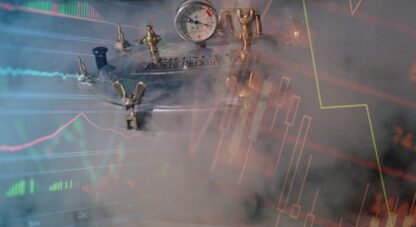What Goes Up…
This was an important week for markets. It did not bring any major change to HAI’s bearish narrative, but rather confirmed it. In five eventful days of news and price moves, stocks were routed, commodities took a hit, and the bond market sold off as yields spiked across the curve. The dollar index finished with its highest weekly close in 20 years as the greenback wrecking-ball kept swinging. Meanwhile, the Goldman Sachs Financial Conditions Index showed financial conditions tightening to levels surpassing the June extremes. At the same time, uniform and deepening inversions throughout the yield curve continued to hoist a very noticeable and recessionary red warning flag.
The major news events of the week were inflation- and earnings-related. Early in the week, it was the August CPI inflation report that elicited quite the negative reaction from markets. On the earnings front, Electrolux and FedEx further spooked markets with earnings warnings and concerned outlooks for global growth.
On Tuesday, the Bureau of Labor Statistics released August’s CPI consumer price inflation report. Headline CPI exceeded expectations with a strong 8.3% year-over-year (y/y) reading. The results beat consensus forecasts for an 8.1% increase and outpaced individual estimates from 47 out of 50 economists. The strong upside surprise came despite the fact that gasoline for the period was down 10.5%, and, broadly, the energy contribution to headline CPI was a negative 5%. The real story was core CPI (ex-food and energy). It registered a 0.6% month-over-month increase that crushed the 0.3% expected, and the y/y reading reached 6.3%, up significantly from last month’s 5.9%.
In a note responding to the resurgent CPI data, Nomura analyst Rob Dent summed things up neatly, saying, “The Fed is going to be looking at this with a lot of concern. There is no good news across this report.” Bank of America’s Michael Gapen ominously noted that the data “suggests that underlying price pressures remain firm and suggests the Fed’s work is only just beginning.” The impact of the report was dramatic and immediately apparent in surging interest rates and plummeting stocks that registered their worst daily performance in two years.
The report seemed to take the market’s hope for a “softish” landing decidedly off the table. In addition to equities, futures market pricing decisively confirmed the validity and growing recognition of the bearish narrative taking hold of markets. In response to CPI, futures markets boosted expectations for more near-term rate hikes and a higher Fed funds terminal rate, while simultaneously significantly increasing the amount of expected subsequent 2023 interest rate cuts. The futures market has now clearly embraced an elegant seesaw relationship whereby the tighter the Fed is expected to take policy in the near term, the greater the expectation that aggressive rate cuts will then follow. The clear implication is that the hawkish Fed is on track to tighten policy until it breaks something, triggers a crisis, and then responds to that crisis with a stimulative emergency policy pivot in 2023. This “crisis signature” in the futures market has been apparent for months. This week, it was greatly accentuated.
So, the Fed is locked on to its hawkish growth-killing policy crusade. It’s being hijacked by institutional credibility chips that are all-in on the inflation fight, and the need for improved inflation data that it’s just not getting. Meanwhile, adding to market stress this week were indications that while the Fed is still ramping up tightening, global growth may already be abruptly turning lower.
Electrolux, the world’s second-largest appliance manufacturer, warned this week that, “market demand for core appliances in Europe and the US so far in the third quarter is estimated to have decreased at a significantly accelerated pace compared with the second quarter.” The company added: “High retailer inventory levels have amplified the impact of the slowdown in consumer demand.”
Later in the week, FedEx withdrew its annual earnings forecast, sending shares of the package-delivery giant tumbling by over 20%. FedEx is seen as a bellwether for global growth because its earnings are highly correlated with the level of business activity among its endless suite of customers.
In a statement, the company said, “Global volumes declined as macroeconomic trends significantly worsened later in the quarter, both internationally and in the US.” Chief Executive Officer Raj Subramaniam continued that, “We are swiftly addressing these headwinds, but given the speed at which conditions shifted, first-quarter results are below our expectations.”
The slowdown in global economic activity is also being reflected in global container freight rates. While still at historically strong levels, rates are now settling into an accelerated slump as traffic slows. The Drewry composite container freight benchmark rate sank 8% this week, and is now down more than 50% from the record seen a year ago.
Again, market concern is increasing that while the Fed is locked into further tightening, the rug is already being yanked out from under global growth. The point was underscored on Thursday when the Atlanta Fed GDPNow real-time model estimate for U.S. Q3 real GDP growth was slashed by more than half to only 0.5%—down significantly from 1.3% as recently as last Friday.
In commodities, the sector moved lower for a third straight week. The main culprit for commodity market weakness was, not surprisingly, the rapidly deteriorating outlook for global growth that is overwhelming tight supply dynamics.
Crude oil and fuel products such as gasoline and diesel were lower on the week. WTI Crude remained in the $80 per barrel range, but continued to whipsaw and remain volatile within its recently lowered range. Crude bounced Tuesday on reports that Biden administration officials had discussed plans to refill the Strategic Petroleum Reserve (SPR) when prices drop below a strike price of $80 per barrel. The perception that U.S. government purchases under $80 per barrel would set a tight floor on prices triggered the rally in black gold. No sooner than a day later, however, the US Department of Energy walked back the reports and crude sold off hard again. The DOE said plans to restock the SPR, now at multi-decade lows, don’t include a price trigger, and added that purchases likely won’t happen until after fiscal year 2023. While these sorts of micro factors will continue to stoke volatility, oil’s primary trend is, for now, largely beholden to the extent and duration of the developing demand destruction dynamics building globally. A partial potential offset to be monitored is if China both reduces Covid lockdowns and can manage some economic traction upon further government stimulus measures.
In the industrial metals market, aluminum and zinc are two of the most energy intensive metals to produce by a wide margin. The energy crisis in Europe is now causing some aluminum and zinc smelters to shut down due to extremely high energy prices and electricity rationing. As a result, production is being curtailed. In addition to potential supply impacts for both the aluminum and zinc markets, silver supply could also be impacted. Roughly 73% of silver production is as a byproduct, and zinc mining produces the most silver. If high electricity price and rationing persist in Europe, supply constraints for each of these metals could be exacerbated.
Back to the unprecedented big picture set-up for the economy and markets in our momentous modern moment: Inflation as policy has been fueling a credit expansion-fueled boom for decades. The politically seductive allure of the credit expansion “carrot” is the power to conjure a supposedly everlasting boom. The reality, however, is that the carrot comes with a stick as the credit boom inevitably turns bust. As economist Ludwig von Mises reminds us, “The credit boom is built on the sands of banknotes and deposits. It must collapse.” Unsustainable and fundamentally unsound in nature, when the bill comes due and the piper demands payment, the policy choice is simple: accept collapse as a consequence of a defective policy approach or roll the dice on a can-kick attempt, feed the credit beast again with more stimulus measures, and grow the ultimate extent of the problem. Mises describes the later action as an “attempt to remedy a present ill by sowing the seeds of a much greater ill for the future.” Regrettably, we’ve been in the financial garden diligently sowing poison seeds for decades now, and unfortunately today is the tomorrow we were anxious to forestall yesterday.
The ruinous outbreak of global consumer price inflation is the game-changing pin that ultimately threatens to pop the towering super bubble our modern monetary maestros have crafted. Inflation has handcuffed policymakers and they now have nothing but bad policy options. With the inflation genie definitively out of the bottle, policymakers cannot feed the credit bubble without stoking an incendiary future of entrenched and accelerating runaway inflation that ultimately culminates in an Austrian crack-up boom-style systemic disaster.
On the other hand, if policymakers permanently abandon the policy of inflation and perpetual credit expansion, they court the likelihood of ensuring a truly devastating deflationary global financial collapse. As Dr. Lacy Hunt put it, in exceptionally understated terms, “they will have difficulty in containing the recession and fostering a recovery.”
An uncontained recession without a recovery is otherwise known as a depression. The concern is far from hyperbole. Early in September, HAI highlighted relevant comments from Jeremy Grantham. Grantham stated that while he expects that the super bubble is about to pop, he is uncertain as to whether it gets “out of hand like it did in the ’30s, is pretty well contained as it was in 2000, or is somewhere in the middle.” Well, the ’30s reference is to the great depression, and an impact of that scale becomes a possibility if, given the nature of our bubble, the Fed permanently and summarily abandons its Keynesian framework and policy of credit expansion. Such a scenario, in which policymakers embrace sound economics, would present a path to a fundamentally healthy, vibrant, and sustainable economy in time. However, that path would be a long and extraordinarily painful one.
With door #1 unthinkable and door #2 unfathomable, what’s behind door #3? The third option is the hybrid approach currently envisioned by the futures market—essentially a Potomac two-step by the Federal Reserve. It entails aggressive front-end rate hikes now (market expectations are up to a nearly 4.5% terminal rate as of this week) into an already unfolding economic downturn. The combined effect would result in a crisis that crushes demand, the economy, and (at least temporarily) reduces inflation. Presumably (according to current futures market pricing), emergency response Fed rate cuts would be the second step. They would quickly follow the appearance of the crisis, and stimulate and reflate the faltering credit super bubble before a full collapse. While HAI expects some version of door #3, HAI does not, however, expect this prognostication by the futures market to go smoothly for risk assets. Not one bit.
For now, the HAI mantra remains the same. Caution and defensive near-term positioning remain rule number one for asset allocation. Helmets and securely fastened safety belts are strongly advised for the rough road ahead. With that said, however, for the patient, the green shoots of exciting longer-term opportunities are germinating. Structurally, the economy has already transitioned from secular disinflation into a new era of relative secular inflation. Accordingly, financial markets are in the throes of a budding secular “regime change” favoring real, hard assets over their financial counterparts. The revenge of the real economy looms, but first, markets must contend with the increasing likelihood of an incoming global recessionary crisis. As events unfold, equities price in further economic weakness, the dollar wrecking ball tops, and the Fed shows signs of a policy pivot; increased positions in hard assets, commodities, and precious metals will be warranted. After all, as Bank of America chief investment strategist Michael Hartnett said this week, “the next bull market will be in ‘regime change’ assets, and new not old leadership.” HAI wholeheartedly agrees.
Weekly performance: The S&P 500 was down 4.77%. Gold was off 2.61%, silver gained 3.25%, platinum gained 2.75%, and palladium was down 2.98%. The HUI gold miners index was down 4.06%. The IFRA iShares US Infrastructure ETF shed 4.72%. Energy commodities were volatile and lower this week. WTI crude oil was down 2.34%, while natural gas was off by 2.90%. The CRB Commodity Index was lower by 1.84%, while copper was down 1.40%. The Dow Jones US Specialty Real Estate Investment Trust Index was lower by 6.20% on the week, while the Vanguard Utilities ETF (VPU) was down 3.52%. The dollar gained by 0.68% to close the week at 109.74. The yield on the 10-yr Treasury jumped 12 bps to end the week at 3.45%
Have a wonderful weekend!
Best Regards,
Morgan Lewis
Equity Analyst & Investment Strategist
MWM LLC
















